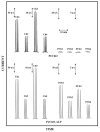A Crosstalk- and Interferent-Free Dual Electrode Amperometric Biosensor for the Simultaneous Determination of Choline and Phosphocholine
- PMID: 34069690
- PMCID: PMC8160789
- DOI: 10.3390/s21103545
A Crosstalk- and Interferent-Free Dual Electrode Amperometric Biosensor for the Simultaneous Determination of Choline and Phosphocholine
Abstract
Choline (Ch) and phosphocholine (PCh) levels in tissues are associated to tissue growth and so to carcinogenesis. Till now, only highly sophisticated and expensive techniques like those based on NMR spectroscopy or GC/LC- high resolution mass spectrometry permitted Ch and PCh analysis but very few of them were capable of a simultaneous determination of these analytes. Thus, a never reported before amperometric biosensor for PCh analysis based on choline oxidase and alkaline phosphatase co-immobilized onto a Pt electrode by co-crosslinking has been developed. Coupling the developed biosensor with a parallel sensor but specific to Ch, a crosstalk-free dual electrode biosensor was also developed, permitting the simultaneous determination of Ch and PCh in flow injection analysis. This novel sensing device performed remarkably in terms of sensitivity, linear range, and limit of detection so to exceed in most cases the more complex analytical instrumentations. Further, electrode modification by overoxidized polypyrrole permitted the development of a fouling- and interferent-free dual electrode biosensor which appeared promising for the simultaneous determination of Ch and PCh in a real sample.
Keywords: alkaline phosphatase; choline analysis; choline oxidase; dual electrode biosensor; electropolymerized non-conducting polymer; enzyme immobilization; flow injection analysis; overoxidized polypyrrole; phosphocholine analysis; simultaneous determination.
Conflict of interest statement
The authors declare no conflict of interest.
Figures









Similar articles
-
Detection of choline in biological fluids from patients on haemodialysis by an amperometric biosensor based on a novel anti-interference bilayer.Bioelectrochemistry. 2019 Oct;129:135-143. doi: 10.1016/j.bioelechem.2019.05.009. Epub 2019 May 23. Bioelectrochemistry. 2019. PMID: 31158798
-
A novel approach for the selective analysis of l-lysine in untreated human serum by a co-crosslinked l-lysine-α-oxidase/overoxidized polypyrrole bilayer based amperometric biosensor.Bioelectrochemistry. 2018 Dec;124:47-56. doi: 10.1016/j.bioelechem.2018.07.004. Epub 2018 Jul 6. Bioelectrochemistry. 2018. PMID: 30007206
-
Electrosynthesized non-conducting polymers as permselective membranes in amperometric enzyme electrodes: a glucose biosensor based on a co-crosslinked glucose oxidase/overoxidized polypyrrole bilayer.Biosens Bioelectron. 1998 Jan 1;13(1):103-12. doi: 10.1016/s0956-5663(97)00064-x. Biosens Bioelectron. 1998. PMID: 9519453
-
Electrosynthesized poly(pyrrole)/poly(2-naphthol) bilayer membrane as an effective anti-interference layer for simultaneous determination of acethylcholine and choline by a dual electrode amperometric biosensor.Biosens Bioelectron. 2006 Mar 15;21(9):1710-8. doi: 10.1016/j.bios.2005.08.005. Epub 2005 Sep 15. Biosens Bioelectron. 2006. PMID: 16169212
-
Assay of serum cholinesterase activity by an amperometric biosensor based on a co-crosslinked choline oxidase/overoxidized polypyrrole bilayer.Analyst. 2018 Feb 12;143(4):920-929. doi: 10.1039/c7an01757j. Analyst. 2018. PMID: 29363680
Cited by
-
An Amperometric Biosensor Based on a Bilayer of Electrodeposited Graphene Oxide and Co-Crosslinked Tyrosinase for L-Dopa Detection in Untreated Human Plasma.Molecules. 2023 Jul 6;28(13):5239. doi: 10.3390/molecules28135239. Molecules. 2023. PMID: 37446900 Free PMC article.
-
A New Approach for Interferent-Free Amperometric Biosensor Production Based on All-Electrochemically Assisted Procedures.Biosensors (Basel). 2025 Jul 22;15(8):470. doi: 10.3390/bios15080470. Biosensors (Basel). 2025. PMID: 40862931 Free PMC article.
References
-
- Kiss Z. Regulation of Mitogenesis by Water-Soluble Phospholipid Intermediates1Abbreviations: PCho—phosphocholine; PEtn—phosphoethanolamine; PtdChoߞphosphatidylcholine; PtdEtn—phosphatidylethanolamine; CK—choline kinase; EK—ethanolamine kinase; PLD—phospholipase D. Cell. Signal. 1999;11:149–157. doi: 10.1016/S0898-6568(98)00057-6. - DOI - PubMed
MeSH terms
Substances
Grants and funding
LinkOut - more resources
Full Text Sources
Miscellaneous

